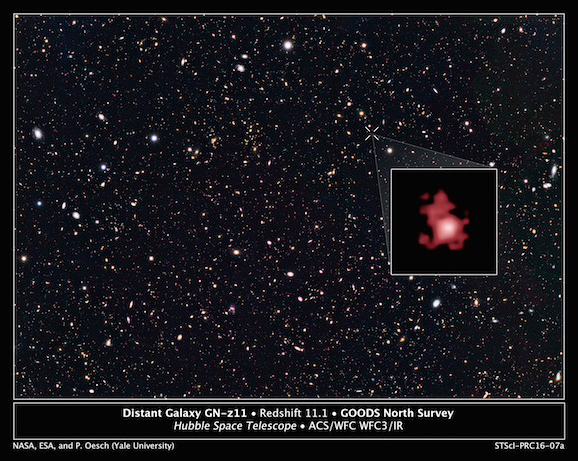Hubble breaks cosmic distance record

An international team of astronomers has pushed NASA's Hubble Space Telescope to its limits to measure the distance to the farthest galaxy we can see, shattering the cosmic distance record.
This surprisingly bright galaxy, named GN-z11, is located 13.4 billion light years away in the direction of the constellation of Ursa Major.
The galaxy, the furthest seen in the Universe, existed just 400 million years after the Big Bang.
The team comprises scientists from Yale University, the Space Telescope Science Institute (STScI) and the University of California. The Australian research contingent includes Dr Michele Trenti from the University of Melbourne and Macquarie University's Dr Lee Spitler.
“We’ve taken a major step back in time, beyond what we’d ever expected to be able to do with Hubble," said principal investigator Pascal Oesch, of Yale University.
"We managed to look back in time to measure the distance to a galaxy when the universe was only 3 per cent of its current age."
This measurement provides additional strong evidence that some unusually bright galaxies found in earlier Hubble images are really at extraordinary distances, closing in on the first galaxies that formed in the universe.
It also reveals surprising new clues about the nature of the first generations of stars formed in the Universe.
“The identification of such a massive and luminous galaxy only 400 million years after the Big Bang indicates that early star formation may be more efficient than we were expecting and that early galaxies grow very rapidly,” Dr Trenti said.
Dr Trenti is an astrophysicist with the University of Melbourne's School of Physics and an Australian Research Council Future Fellow.
“It will be important to identify more objects like GN-z11 to infer how rare - or common - these sources are, and we have an ongoing Hubble observational campaign that will contribute to provide an answer to this question."
Indeed, this rapid growth might be a challenge for current models.
“Observations of such a massive galaxy during this infant stage of the Universe provides a challenge to our models of early galaxy formation,” said University of Melbourne Professor Stuart Wyithe.
Professor Wyithe was not involved in the study but is leading a major effort to simulate on supercomputers the formation of galaxies during the first billion years of the Universe's life.
This discovery has important consequences for upcoming Australian observations with the Murchison Widefield Array (MWA) radio telescope, which will study the process of cosmic re-ionization.
Professor Rachel Webster, a fellow University of Melbourne academic who was not involved in the study, labelled it an "extraordinary measurement".
"The fact that we are seeing galaxies at these redshifts means that the signal must be in the MWA datasets,” she said.
In fact, the light from young stars of galaxies like GN-z11 is expected to ionize the neutral hydrogen gas, making the Universe transparent to radiation.
The MWA will be able to observe the transition of the gas from neutral to ionized, providing complementary evidence to these Hubble observations to understand star formation in the youth of the Universe.
The new Hubble observations take astronomers into a realm that was once thought to be only reachable with NASA’s upcoming James Webb Space Telescope.
Previously, astronomers had estimated GN-z11’s distance by determining its colour through imaging with Hubble and NASA’s Spitzer Space Telescopes.
Now, for the first time for a galaxy at such extreme distances, the team used Hubble’s Wide Field Camera 3 to precisely measure the distance to GN-z11 spectroscopically by splitting the light into its component colours.
The team’s findings will appear in the March 8, 2016 edition of the Astrophysical Journal.